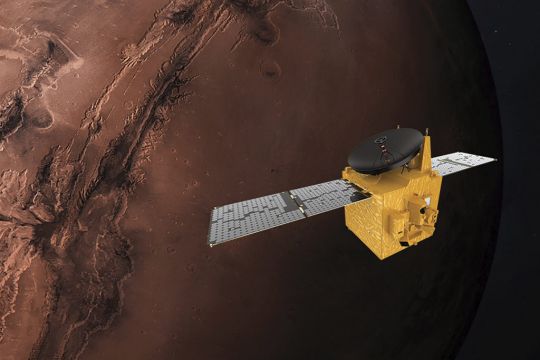Three robotic explorers are due to reach Mars within days of each other, after hurtling hundreds of millions of miles through space.
The United Arab Emirates’ orbiter reaches Mars on Tuesday, followed less than 24 hours later by China’s orbiter-rover combo.
Nasa’s rover will arrive on the scene a week later, on February 18, to collect rocks for return to Earth — a key step in determining whether life ever existed on Mars.
Both the UAE and China are newcomers to Mars, where more than half of Earth’s emissaries have failed. China’s first Mars mission, a joint effort with Russia in 2011, never made it past Earth’s orbit.

“We are quite excited as engineers and scientists, at the same time quite stressed and happy, worried, scared,” said Omran Sharaf, project manager for the UAE.
All three spacecraft rocketed away within days of one another last July, during an Earth-to-Mars launch window that occurs only every two years. That is why their arrivals are also close together.
Called Amal, or Hope in Arabic, the Gulf nation’s spacecraft is seeking an especially high orbit — 13,500 by 27,000 miles high — all the better to monitor the Martian weather.
China’s duo — called Tianwen-1, or “Quest for Heavenly Truth” — will remain paired in orbit until May, when the rover separates to descend to the surface. If all goes well, it will be only the second country to land successfully on the red planet.
The US rover Perseverance, by contrast, will dive in straight away for a harrowing sky-crane touchdown similar to the Curiosity rover’s grand Martian entrance in 2012. The odds are in Nasa’s favour: It has nailed eight of its nine attempted Mars landings.

Despite their differences — the one-ton Perseverance is larger and more elaborate than the Tianwen-1 rover — both will prowl for signs of ancient microscopic life.
Perseverance’s mission is the first leg in a US-European effort to bring Mars samples to Earth in the next decade.
“To say we’re pumped about it, well that would be a huge understatement,” said Lori Glaze, Nasa’s planetary science director.
Perseverance is aiming for an ancient river delta that seems a logical spot for once harbouring life. This landing zone in Jezero Crater is so treacherous that Nasa cancelled it for Curiosity, but so tantalising that scientists are keen to get hold of its rocks.
“When the scientists take a look at a site like Jezero Crater, they see the promise, right?” said Al Chen, who is in charge of the entry, descent and landing team at Nasa’s Jet Propulsion Laboratory in Pasadena, California. “When I look at Jezero, I see danger. There’s danger everywhere.”
Steep cliffs, deep pits and fields of rocks could cripple or doom Perseverance, following its seven-minute atmospheric plunge. With an 11-and-a-half-minute communication lag each way, the rover will be on its own, unable to rely on flight controllers.
What would be a sign of ancient life on Mars? @NASAPersevere will be searching!
In the newest Rocket Ranch podcast, @NASAJPL's Dr. Moogega Cooper shares her expertise on the rover's astrobiology mission.
Listen, subscribe, and #CountdownToMars: https://t.co/zKEkBlMJ8R pic.twitter.com/smiFrF3Dca— NASA (@NASA) February 6, 2021
Faster than previous Mars vehicles but still moving at a glacial pace, the six-wheeled Perseverance will drive across Jezero, collecting core samples of the most enticing rocks and gravel. The rover will set the samples aside for retrieval by a fetch rover launching in 2026.
Under an elaborate plan still being worked out by Nasa and the European Space Agency, the geologic treasure would arrive on Earth in the early 2030s. Scientists contend it is the only way to ascertain whether life flourished on a wet, watery Mars three billion to four billion years ago.
Nasa’s science mission chief, Thomas Zurbuchen, considers it “one of the hardest things ever done by humanity and certainly in space science”.
The US is still the only country to successfully land on Mars, beginning with the 1976 Vikings. Two spacecraft are still active on the surface: Curiosity and InSight.
Smashed Russian and European spacecraft litter the Martian landscape, meanwhile, along with Nasa’s failed Mars Polar Lander from 1999.
Getting into orbit around Mars is less complicated, but still no easy matter, with about a dozen spacecraft falling short. Mars fly-bys were the rage in the 1960s and most failed; Nasa’s Mariner 4 was the first to succeed in 1965.
Six spacecraft currently are operating around Mars: three from the US, two from Europe and one from India. The UAE hopes to make it seven with its mission.
The UAE is especially proud that Amal was designed and built by its own citizens, who partnered with the University of Colorado at Boulder and other US institutions, not simply purchased from abroad. Its arrival at Mars coincides with this year’s 50th anniversary of the country’s founding.







